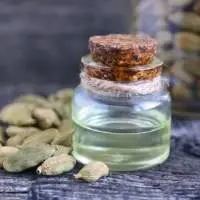
What does Cedarwood Himalayan smell like? Aroma: Dry, woody, warm and balsamic with a slightly crude/camphoraceous top note; it displays a delicately sweet-woody aroma and good tenacity in the drydown. What is Himalayan cedarwood oil good for? Used medicinally, Cedarwood Essential Oil is reputed to protect the body against harmful bacteria, facilitate wound-healing, address the discomforts of muscle aches, joint pain or stiffness, soothe coughs as well as spasms, support the health of the organs, regulate menstruation, and stimulate circulation. Is cedarwood good for skin? Image result Cedarwood essential oil contains anti-inflammatory, antifungal, and antibacterial properties that enable it to treat irritated skin as well as conditions like acne and eczema. It has a natural wound-healing quality, making it ideal for use on scrapes, cuts, and other abrasions that require disinfection, says Dr.
Discover the essence of purity with Giva Agro's 100% Pure Himalayan Origin Lemongrass Essential Oil! Sourced from the pristine heights of the Himalayas, our Lemongrass Oil is perfect for rejuvenating your mind and body. Whether for aromatherapy, skincare, or a refreshing home fragrance, let nature's finest elevate your wellness journey.
Giva Agro's Himalayan Origin Essential Oils are crafted with the purest ingredients sourced from the pristine and majestic Himalayas. Each oil captures the essence of this serene region, offering unparalleled quality and therapeutic benefits. From soothing Lavender and invigorating Peppermint to calming Chamomile, our essential oils bring the purity and freshness of the Himalayas directly to you. Experience nature's best with Giva Agro's 100% pure and natural essential oils.
Cardamom essential oil has a unique sweet-spicy aroma compared to the rest of the spice oils. Users appreciate it as an aroma, flavor, and wellness ingredient. Aromaaz International is also one of the top cardamom essential oil exporters and also provides all the spice essential oils with different aroma nuances. Botany Cardamom, also known as green or true cardamom is a herbaceous perennial plant in Zingiberaceae (Ginger) family. It is native to Southern India, but many countries such as China, Thailand, Sri Lanka, Indonesia, Guatemala, Costa Rica, and others in tropical regions have naturalized it and now cultivate it extensively. Typically, the plant grows with an average height of 2-4 meters with alternate leaves in two ranks, white to lilac violet flowers, and three-sided yellow-green fruit pods (cardamom). The fruit pods contain 15 to 20 tiny black or brown seeds. People use dried green pods in tea, coffee, cuisines, and desserts. Cardamom Essential Oil Cardamom pods and seeds are known for their intense sweet-spicy aroma and taste. The cardamom essential oil manufacturers distill the pods and seeds to derive a thin clear oil with a spicy, woody, rich, and sweet fragrance. The oil is an excellent amalgamation of fragrance, flavor, and medicinal properties governed by its constituents such as 1,8-cineole, linalyl acetate, linalool, a-terpinyl acetate, and limonene. It possesses antispasmodic, digestive, expectorant, antiseptic, and stimulant properties. A Brief History of Cardamom Essential Oil Cardamom is a household spice used in powdered form or whole in India. The traditional Chinese and Indian healthcare experts added it to many herbal formulations for treatment. Ayurvedic practitioners have used cardamom in ayurvedic medicines since the 4th century BC. Greek physicians recognized its therapeutic properties and used it as a digestive aid. India has been the largest producer of cardamom and cardamom essential oil. It began to export cardamom and its derivatives to Europe by the end of the 13th century. Arabian countries also imported cardamom and cardamom oil from India. Cardamom essential oil imparts the same wellness benefits and aroma as cardamom spice. It has received the attention of fragrance and flavor connoisseurs in the late 20th century.
Cardamom Oleoresin 40% VOC is extracted by steam distillation from the seeds of the fruit gathered just before they are ripe. The dark brown oleoresin is a yellow liquid with a sweet-spicy, warming fragrance. It is non-toxic in nature and is widely used as a food contaminant. Cardamom oleoresin is listed in the British Herbal Pharmacopoeia as a 'specific' for flatulence and dyspepsia. Features: Non-toxic in nature Used as a fragrance component Used as a domestic spice Common Names: Cardamom, Cardomomi, Musore Constituents: Alpha Terpinyl Acetate, Cineol, Linalol, Linalyl Acetate and Limonene Uses: Widely used as a domestic spice, especially in India, Europe, Latin America and Middle Eastern countries. The oleoresin is employed in some carminative, stomachic and laxative preparations. Widely used as a fragrance component in soaps, cosmetics and perfumes especially oriental types. Important flavor ingredient particularly in curry and spice products.
Cardamom Oil, derived from Amomum cardamomum and originating from Indonesia, is a pure essential oil extracted through steam distillation. The oil is pale yellow to yellowish in color and possesses a characteristic aroma. It is widely utilized in cosmetics, medicine, toiletries, and skincare products. The main constituents of Cardamom Oil include 1,8-cineole, a-terpinyl acetate, linalyl acetate, (+)-limonene, and linalool. This oil is certified with COA and MSDS, ensuring its quality and compliance with international standards.
Supplier: Oleoresin, black pepper, turmeric, clove, nutmeg, dehydrated garlic granules, garlic powder, sesame, cumin, coriander, yellow peas, green peas, millet, guar gum, psyllium husk, peanut, raisin, spices, capsicum oleoresin, paprika oleoresin, onion powder, dry red chilli, cassia, cinnamon, tamarind, wheat, oats, potato flakes, french fries, pigeon peas, green mung, red kidney beans, desiccated coconut, black pepper spent, black pepper pinhead, mustard seeds, chickpeas, ascorbic acid, soybean, soybean meal, yellow corn, flavour, peanut butter, butter, ghee, almond, breakfast cereals, frozen vegetables, essential oil
Services: Marketing





